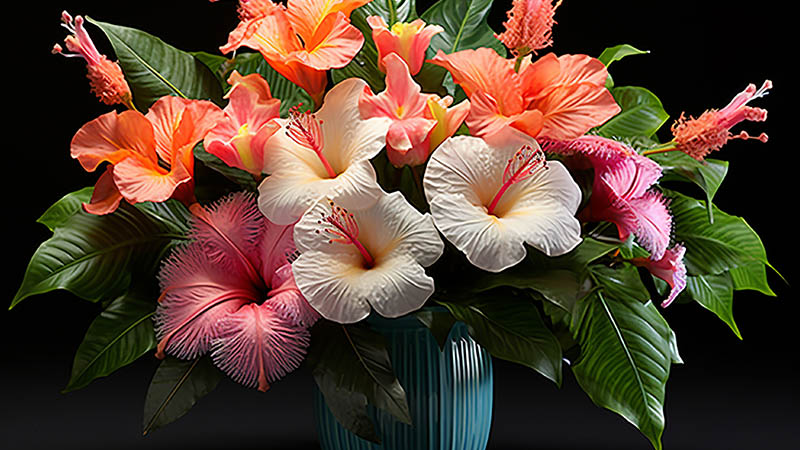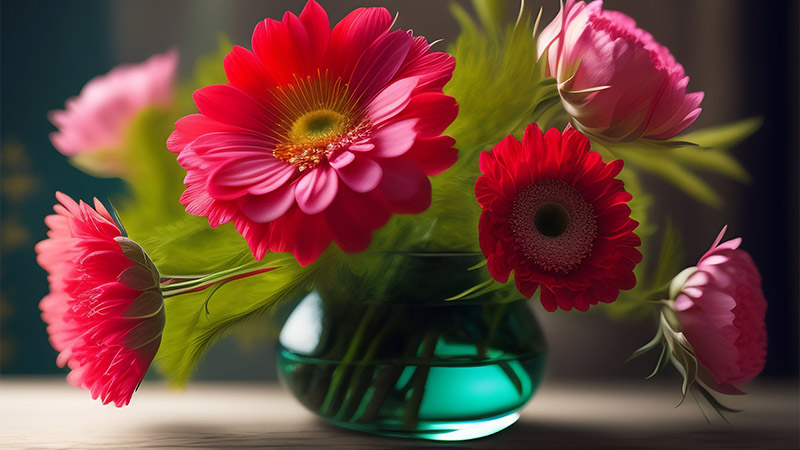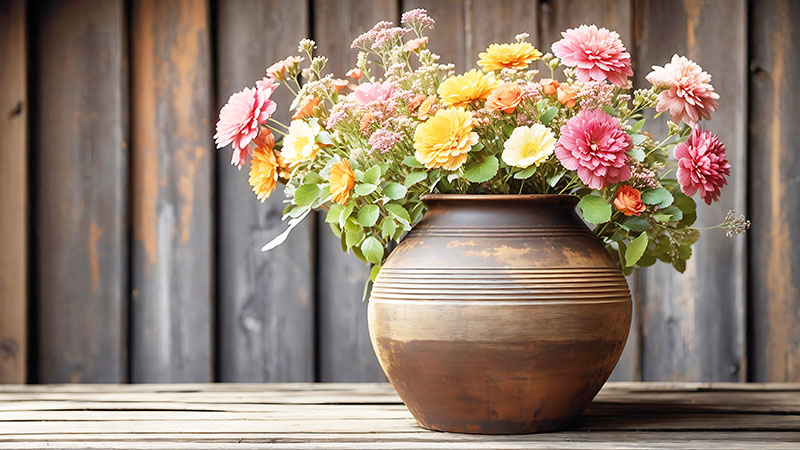How to Make Artificial Flowers Look Real: A Step-by-Step Guide

Artificial flowers have come a long way in terms of realism, but with a few simple techniques, you can take their appearance to the next level. In this comprehensive guide, we’ll explore step-by-step methods for how to make artificial flowers look real, from enhancing their texture to adding natural-looking imperfections.
Choosing High-Quality Artificial Flowers
Choosing high-quality artificial flowers is essential to achieving a realistic look in your floral arrangements. When selecting artificial flowers, there are several factors to consider to ensure you’re getting the best possible quality. One important aspect is the material used to make the flowers.
Opt for flowers made from high-quality materials such as silk, latex, or high-grade plastic. These materials closely mimic the look and feel of real flowers, providing a more authentic appearance. Considering these factors is crucial in understanding how to make artificial flowers look real.
Another consideration is the level of detail in the artificial flowers. Look for flowers that feature realistic details such as natural-looking color variations, intricate petal shapes, and lifelike textures.
Flowers with well-defined veins on the petals and subtle imperfections will appear more natural when arranged in a bouquet or centerpiece.
Additionally, pay attention to the overall construction of the artificial flowers. Ensure that the stems are sturdy and flexible, allowing you to arrange them easily and achieve a natural look. Avoid flowers with stems that feel flimsy or brittle, as they may not hold up well over time.
Read More: How to paint artificial flowers?
Lastly, consider the reputation of the manufacturer or brand when purchasing artificial flowers. Look for reputable brands known for producing high-quality artificial flowers that are indistinguishable from the real thing.
Reading customer reviews and testimonials can also provide valuable insights into the quality and durability of the flowers.

By carefully selecting high-quality artificial flowers, you can create stunning floral arrangements that rival the beauty of fresh flowers.
Investing in top-notch artificial flowers will ensure that your arrangements look realistic and lifelike, adding a touch of beauty to any space. This attention to detail is key to understanding how to make artificial flowers look real.
Enhancing Texture and Realism
When it comes to making artificial flowers look real, enhancing their texture is crucial. Real flowers have a variety of textures, from the softness of petals to the roughness of stems, and replicating these textures can make a big difference in the realism of artificial arrangements.
In this section, we’ll explore some techniques for enhancing the texture and realism of artificial flowers to help you achieve a more lifelike look. Incorporating these techniques is essential for mastering the art of how to make artificial flowers look real.
Adding Veins to Petals
One effective way to enhance the texture of artificial flowers is by adding veins to the petals. Real flower petals often have delicate veins that add depth and detail to their appearance. To mimic this natural feature, you can use a fine-tipped brush and acrylic paint to carefully paint veins onto the petals of your artificial flowers.
Choose a paint color that complements the color of the petals and apply it in thin lines following the natural lines of the petals. Be sure to blend the paint gently to create a subtle, realistic effect.
Read More: How to protect artificial flowers outside?
Creating Natural Bends and Curves
Another important aspect of texture in artificial flowers is creating natural bends and curves in the stems and petals. Real flowers often have organic, irregular shapes that give them their lifelike appearance. To mimic this, gently bend the stems and petals of your artificial flowers to create natural-looking curves and bends.
Avoid making the bends too uniform or symmetrical, as this can make the flowers look artificial. Instead, aim for variation in shape and angle to create a more realistic effect.
Adding Realistic Dust and Debris
In addition to enhancing the texture of the petals and stems, adding realistic dust and debris can also contribute to the overall realism of artificial flowers. Real flowers often have small particles of dust and debris on their petals, especially if they’ve been sitting outside or in a dusty environment.
To mimic this natural effect, you can lightly spray your artificial flowers with water and then dust them with a mixture of cinnamon and cocoa powder. Focus on areas where dust would naturally accumulate, such as the edges of petals and the center of the flower, to create a subtle, realistic effect.

Incorporating Natural Imperfections
Real flowers are never perfectly symmetrical or flawless, and incorporating natural imperfections into artificial flowers can make them look more realistic. From subtle variations in petal color to small tears and wrinkles, these imperfections add depth and character to artificial arrangements.
In this section, we’ll explore some techniques for incorporating natural imperfections into your artificial flowers to help you achieve a more lifelike appearance. This is how to make artificial flowers look real.
Introducing Variation in Petal Color
One effective way to add natural imperfections to artificial flowers is by introducing variation in petal color. Real flowers often have subtle differences in color from petal to petal, giving them a more organic appearance.
To mimic this effect, you can use a combination of acrylic paints in different shades to add variation to the petals of your artificial flowers. Apply the paint sparingly and blend it gently to create a natural-looking gradient. Focus on areas where shadows would naturally fall, such as the base of the petals and along the edges, to create depth and dimension.
Read More: How to Cut Artificial Flowers: Expert Advice for Clean and Professional Results
Adding Wilted or Damaged Petals
Another way to incorporate natural imperfections into artificial flowers is by adding wilted or damaged petals. Real flowers can often develop small tears, holes, or wilting as they age, giving them a more authentic appearance.
To mimic this effect, you can use scissors to carefully cut small tears or holes in the petals of your artificial flowers. Be subtle with this technique, as too many tears or holes can make the flowers look artificial. Focus on creating small, irregular imperfections that add character without detracting from the overall beauty of the arrangement.
Mimicking Natural Growth Patterns
In addition to adding imperfections to individual petals, you can also incorporate natural imperfections by mimicking the overall growth patterns of real flowers. Real flowers often grow in organic, irregular patterns, with some stems bending and others standing upright.
To mimic this effect, arrange the flowers in a way that mimics their natural growth patterns, with some stems bending and others standing upright. Avoid arranging the flowers too perfectly or symmetrically, as this can detract from the realism of the arrangement. Instead, aim for a more natural, organic look that captures the beauty of real flowers in nature.

Enhancing Scent and Freshness
While artificial flowers may lack the natural fragrance of real blooms, adding a subtle scent can enhance their realism and create a more immersive experience. Whether you prefer floral or fruity scents, there are several ways to incorporate fragrance into your artificial flower arrangements.
In this section, we’ll explore some techniques for enhancing the scent and freshness of your artificial flowers to help you achieve a more lifelike effect. Incorporating fragrance is an essential aspect of how to make artificial flowers look real, as it engages multiple senses and adds to the overall authenticity of the arrangement.
Read More: How to Clean Artificial Silk Flowers: Easy and Effective Methods
Using Scented Oils or Sprays
One of the easiest ways to add scent to artificial flowers is by using scented oils or sprays. There are a wide variety of floral, citrus, and herbal scents available, allowing you to choose a fragrance that complements the type of flower you’re using.
To apply the scent, simply spray a small amount onto the petals of your artificial flowers, being careful not to saturate them. Allow the scent to dry before displaying your arrangement to avoid any potential damage to the flowers.
Choosing the Right Scent
When selecting a scent for your artificial flowers, consider the type of flower you’re using and the overall aesthetic you’re trying to achieve. For example, floral scents like rose or jasmine are perfect for classic flower arrangements, while citrus or herbal scents may be better suited to more contemporary designs. Experiment with different scents to find the perfect fragrance for your artificial flowers.
Applying the Scent
When applying scented oils or sprays to your artificial flowers, it’s important to use them sparingly to avoid overpowering the fragrance. Start by spraying a small amount onto the petals, then gradually add more if desired until you achieve the desired level of scent.
Be sure to allow the scent to dry completely before displaying your arrangement to ensure that it doesn’t transfer onto other surfaces.
Placing Near Natural Fragrances
Another way to enhance the scent of your artificial flowers is by placing them near natural sources of fragrance. Scented candles, potpourri, or fresh fruit can all help to create a more realistic environment and enhance the overall experience of your artificial flower arrangements.
Experiment with different combinations of scents to create a unique and inviting atmosphere in your home or office.
Creating a Scented Environment
To create a truly immersive experience, consider incorporating multiple sources of fragrance into your space. For example, you could place scented candles or diffusers around the room, along with your artificial flower arrangements, to create a cohesive and inviting atmosphere.
Be mindful of the overall scent profile and avoid mixing too many strong or conflicting fragrances to ensure a harmonious environment.
Refreshing the Scent
Over time, the scent of your artificial flowers may start to fade. To refresh the scent, simply reapply scented oils or sprays as needed, or move the flowers to a different location with fresher natural fragrances. With a little bit of maintenance, you can enjoy the beauty and fragrance of your artificial flower arrangements for years to come.

Paying Attention to Detail
Attention to detail can make all the difference when it comes to making artificial flowers look real. From carefully arranging each stem to adding small touches of realism, every aspect of your arrangement contributes to its overall authenticity.
In this section, we’ll explore some techniques for paying attention to detail and achieving lifelike results with your artificial flower arrangements. How to make artificial flowers look real? Let’s delve into the intricacies of crafting truly lifelike floral displays.
Arranging Each Stem with Care
One of the most important aspects of making artificial flowers look real is arranging each stem with care. Real flowers often have an organic, asymmetrical appearance, with some stems bending and others standing upright.
To mimic this natural look, take the time to arrange each stem individually, adjusting the angle and spacing as needed to create a balanced composition. Avoid arranging the flowers too perfectly or symmetrically, as this can detract from the realism of the arrangement.
Adding Small Touches of Realism
In addition to arranging the stems, adding small touches of realism can also help to enhance the overall appearance of your artificial flower arrangement. Consider incorporating elements such as faux dew drops, tiny insects, or even small pieces of foliage to add depth and interest to your arrangement.
These small details may seem insignificant on their own, but they can make a big difference in the overall realism of your arrangement.
- Faux Dew Drops: To create the illusion of dew drops on your artificial flowers, use a clear adhesive such as glue or resin to carefully apply small droplets to the petals. Be strategic in your placement, focusing on areas where dew would naturally accumulate, such as the tips of petals or along the edges of leaves. Allow the adhesive to dry completely before displaying your arrangement to ensure that the dew drops stay in place.
- Tiny Insects: For an added touch of realism, consider incorporating tiny insects into your artificial flower arrangement. You can find realistic-looking faux insects at craft stores or online, or you can create your own using small beads or wire. Arrange the insects strategically throughout the arrangement, focusing on areas where they would naturally be found, such as nestled among the petals or crawling along the stems.
Maintaining a Natural Appearance
Finally, when paying attention to detail, it’s important to maintain a natural appearance throughout your arrangement. This means avoiding overly uniform or symmetrical arrangements and embracing the imperfections that make real flowers unique.
Take inspiration from nature and allow your arrangement to evolve organically, adjusting and refining as needed to achieve the desired look. With a little bit of patience and attention to detail, you can create stunningly realistic artificial flower arrangements that will impress even the most discerning eye.

Conclusion
With the right techniques and attention to detail, you can easily make artificial flowers look real. By enhancing texture, incorporating natural imperfections, and adding subtle fragrance, you can create stunning floral arrangements that rival the beauty of real flowers.
Follow the step-by-step guide outlined in this article to achieve lifelike results and enjoy the beauty of artificial flowers in your home decor. Whether you’re a seasoned crafter or a novice decorator, these tips and tricks will show you how to make artificial flowers look real with minimal effort.





